Oaxaca City, Oaxaca 作者: 来源: 发布时间:2021-05-27
1. Population and Area
Population: 300,050 (2014)
Metropolitan area: 650K
Área: 85.48 km2 (33.00 sq mi)
Oaxaca City inside the state of Oaxaca
Source: http://ontheworldmap.com/mexico/city/oaxaca/
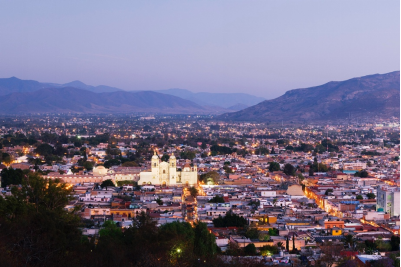
2. Natural geography
Located 488 km (via superhighway) and 583 km (via federal road) Southeast of Mexico City, the city of Oaxaca de Juárez, head of the homonymous municipality, is located in the Central Valleys region of Oaxaca, in the Downtown District, between parallels 17 ° 01 'and 17 ° 10' north latitude; meridians 96 ° 40 'and 96 ° 47' of west longitude; with an altitude between 1500 and 3,200 m; occupying 0.09% of the total surface of the state with a territorial extension of 85.48 km².
Oaxaca de Juárez is located in the middle of a set of three river valleys located between the Mixtec Nudo, the Sierra Juárez and the Sierra Madre del Sur. These three valleys make up a kind of "Y" where each of the arms has a specific name: to the northwest is the Etla valley; to the east, the Tlacolula valley; and to the south, the valley of Zimatlán-Ocotlán. The city is surrounded by several elevations, standing out to the north the hill of San Felipe del Agua (at 3,500 masl) where the Benito Juárez National Park is located, to the south the hill of Monte Albán, to the east the hill of San Antonio de la Cal and to the northwest the hills of Creston and Fortín, the latter decreed on October 30, 2004 as a State Park.
Weather
Oaxaca has a tropical savanna climate (Köppen climate classification Aw), closely bordering on a humid subtropical climate (Cwa), due to its high altitude. During the dry season, temperatures during the day remain warm with an average high of 27.1 °C (80.8 °F) in the coolest month, December, and an average high of 33.3 °C (91.9 °F) in April, just before the beginning of the wet season. Although daytime temperatures are warm, nighttime temperatures are cool with an average low of 9 °C (48 °F) in January. Due to its altitude of 1,555 metres (5,102 ft), the climate of Oaxaca is cooler than lowland areas at the same latitude. Precipitation is concentrated in the summer months with June being the wettest with an average precipitation of 171 mm (6.7 in).
Flora and Fauna
Oaxaca has a great variety of flora and fauna, both indigenous and introduced. The predominant vegetation in the valleys corresponds to trees (evergreen and deciduous) such as ahuehuete (Taxodium mucronatum), casuarina (Casuarina equisetifolia), framboyan (Delonix regia), sage (Salvia officinalis), fennel (Foeniculum vulgare), mulatto wood (Bursera) simaruba), thyme (Thymus), huamúchil (Pithecellobium dulce), hunt (Ipomoea arborea), laurel (Ficus nitida) and huaje (Leucaena leucocephala), from which the name of the city comes.
Within the wild fauna we can find the cenzontle (Mimus polyglottos), the goldfinch (Carduelis carduelis), the house sparrow (Passer domesticus), the common calender (Mimus saturninus), pigeons (Columba livia domestica), turtles (Columbina talpacoti), opossums (Marmosa mexicana), squirrels, badgers and raccoons; among the domestic: the horse, the cat, the dog, chickens, among others.
Seismicity
The geological risks (earthquakes, landslides and faults) stand out in the city of Oaxaca. Like the State, it has the highest seismicity in the country Throughout its history, being in a highly seismic area, the city has been partially or almost totally destroyed by earthquakes. To mention, the one registered on January 15, 1931 of magnitude 7.8 (which damaged public buildings, as well as temples and ex-convents in populations of the Valley of Oaxaca) and the one of September 30, 1999 of magnitude 7.4.
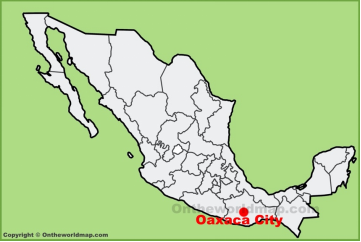
Getting there and around
Air
Oaxaca Airport is 6km south of the city, 500m west off Hwy 175, and is served by numerous airlines: Aeroméxico, Aerotucán, Interjet, TAR Aerolíneas, United (flies to Houston and Texas daily), Vivaaerobus (budget airline), Volaris (Low-cost).
Bus & Van
For destinations on the Oaxaca coast, buses from the 1st-class bus station take a long and expensive route via Salina Cruz. Unless you’re prone to travel sickness on winding mountain roads, it’s cheaper and quicker to use one of the comfortable 12- to 18-seat van services that go directly to Puerto Escondido, Pochutla, Zipolite, Mazunte or Huatulco (prices from between M$195 and M$230). Some hostels can arrange for these services to pick you up for an extra charge of around M$50.
New highways to Puerto Escondido and Tehuantepec, when they eventually open, will reduce journey times to coastal destinations and are likely to affect schedules and routes of some services.
1st-class bus station Two kilometers northeast of the Zócalo; used by ADO Platino and ADO GL (deluxe service), ADO and OCC (1st class) and AU, Sur and Cuenca (2nd class). You can book online at Mi Escape.
2nd-class bus station Mainly useful for some buses to villages around Oaxaca; it's 1km west of the Zócalo.
Car & Motorcycle
Hwy 135D branches off the Mexico City–Veracruz highway (150D) to make a spectacular traverse of Oaxaca’s northern mountains to Oaxaca city. Automobile tolls from Mexico City to Oaxaca total M$430; the trip takes five to six hours.
The roads of Oaxaca state are mostly poorly maintained. Promised new highways to the coast have been in the works for nearly 10 years but have yet to reach fruition. The touted termination date of 2018 sounds generous. Away from Oaxaca city, traffic is light and the scenery is fantastic.
Walk-in car rental prices in Oaxaca start around M$700 a day with unlimited kilometers.
Source: https://www.lonelyplanet.com/mexico/oaxaca-state/oaxaca/narratives/practical-information/transport/getting-there-away
Bicycle
Two full-service shops, Bicicletas Pedro Martínez and Mundo Ceiba rent out good mountain bikes and also sell bikes and equipment. Central Oaxaca is excellent for cycling.
Bus
City buses cost M$7.50. From the main road outside the 1st-class bus station, westbound ‘Juárez’ buses will take you down Juárez and Ocampo, three blocks east of the Zócalo; westbound ‘Tinoco y Palacios’ buses go down Tinoco y Palacios, two blocks west of the Zócalo. To return to the bus station, take an ‘ADO’ bus north up Pino Suárez or Crespo.
Taxi
Taxis anywhere within the central area, including the bus stations, cost M$40.
Colectivos
Colectivos are shared taxis that run along fixed routes in the localities in and around Oaxaca. However, because you are sharing the ride with other people, the cost is a lot cheaper than a regular taxi (but slightly more expensive than a bus). In Oaxaca, colectivos are dark red and white and display their destination on a banner at the top of the windscreen. Many congregate at the north side of Oaxaca’s 2nd-class bus station, but will stop unscheduled en route to pick up passengers if they have room (stick your arm out to flag one down). Colectivos carry four passengers and leave when full (some try to squeeze in five people). They are generally faster than buses – some would say a little too fast!
Source: https://www.lonelyplanet.com/mexico/oaxaca-city/practical-information/transport/getting-around/a/nar/9d303e6f-d7f3-428c-bc49-8f93494b0c64/361604
3. Economy
In 2013, the GDP of Oaxaca City was calculated at more than 19 million MXN. Presumably, to this year it would be over the 20 million MXN (1.5 million USD).
Source: http://www.diputados.gob.mx/sedia/biblio/usieg/Anuarios_2016/Oaxaca/11%20Informaci%C3%B3n%20econ%C3%B3mica%20agregada.xls
4. Industry
The city is the primary attraction of the state, which also relies economically on tourism. From 1984 to 2009, tourism grew to become the dominant factor in Oaxaca's economy. The attractions are the verdant landscapes of the Oaxaca Valley, and the architectural and cultural charms of the city itself. 77% of the municipality of Oaxaca has employment that is related in some way to tourism. The 2006 Oaxaca protests had a severe negative impact on the city's main generator of revenue: tourism. The next largest economic sectors are mining and manufacturing, which employ 20% of the work force.
The city centre was included in a World Heritage Site designated by UNESCO, in recognition of its treasure of historic buildings and monuments. Tourist activity peaks in three seasons: Holy Week, summer (especially during Guelaguetza) and New Year. Many of the tourists who come during Holy Week and for New Year come from other parts of Mexico and include native Oaxacans returning to visit from their places of work. Most international visitors come during the summer.
Interoceanic corridor
The interoceanic corridor is a mega infrastructure project to enhance the productivity and commercial capabilities of the entire Southeast region of Mexico, which includes Oaxaca, Veracruz, Chiapas, Guerrero and Yucatan.
The main development of the corridor will be a railroad that will connect ports among the two coastal areas of the Southeast with their respective ports to the Pacific and Atlantic oceans.
This, presumably, will benefit the entire economy of the Oaxaca state and City, and will make the state less dependent on tourism, to make the State, also, an industrial and commercial hub.
According to Government plans, the project would be fully operational by 2023.
Source: https://www.oaxaca.gob.mx/comunicacion/corredor-interoceanico-de-tehuantepec-clave-para-el-comercio-global/
https://www.energiaadebate.com/electricidad/publican-programa-para-el-corredor-del-istmo-de-tehuantepec/
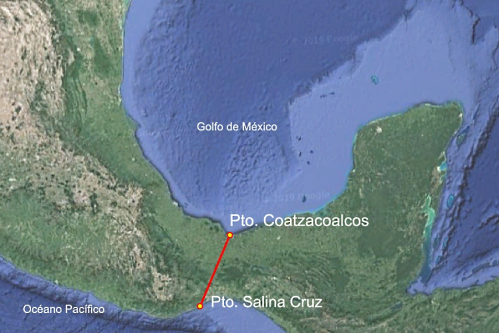
Map of the Transoceanic corridor project
5. Touristic sites
Oaxaca City is full of landmarks and places to visit with cultural and historic relevance. Oaxaca’s entire Historic Centre is cataloged as World Cultural Heritage by UNESCO.
Church of Santo Domingo
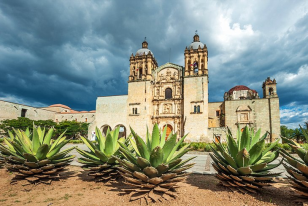
As its name implies, the church and monastery were founded by the Dominican Order. Begun in 1575, they were constructed over a period of 200 years, between the 16th and 18th centuries. The monastery was active from 1608 to 1857. In the period of the revolutionary wars, the buildings were turned over to military use, and from 1866 to 1902 they served as a barracks. The church was restored to religious use in 1938, but the monastery was made available to the Universidad Autónoma Benito Juárez de Oaxaca. In 1972 it became a regional museum, and in 1993 the decision was taken to undertake a full restoration. This was completed in 1999. It is an exceptional example of conservation architecture.
The church has also been fully restored. Its highly decorated interior includes use of more than 60,000 sheets of 23.5-karat gold leaf.
Source: https://en.wikipedia.org/wiki/Church_of_Santo_Domingo_de_Guzm%C3%A1n
Rufino Tamayo Museum

The Rufino Tamayo Museum (Museo Rufino Tamayo), presented to the state by famous Mexican artist Tamayo, lies in an old palace just a short walk away from the Zócalo. In addition to displaying archaeological objects from Mexico's many Indian cultures, this rich collection of Pre-Columbian art was established to ensure the more than 1,000 historic artifacts collected over Tamayo's lifetime remained intact and safe from illegal traders.
Also worth a visit is the Graphic Arts Institute of Oaxaca (Instituto de Artes Gráficas de Oaxaca, or IAGO), founded by another Mexican artist, Francisco Toledo, and containing numerous fine paintings from across Latin America, as well as a cultural center, a library with many rare manuscripts, and a music library.
Casa Juárez Museum
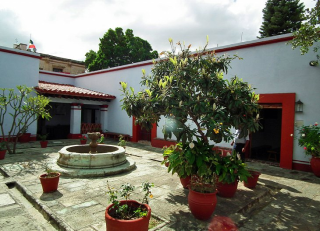
The humble looking home at García Vigil 609, now a museum, is famous in Mexico for being the place where much revered President Benito Juárez lived as a servant from 1818 until 1828. Don't be deceived by the home's rather plain exterior. Inside, the complex opens up into a large central courtyard and houses Museo Casa Juárez, a large museum containing related memorabilia (the President was in fact born in 1806 in nearby Guelatao). Fun activities include exploring the museum's portrayal of the daily life of both working and middle classes in the 19th century, as well as the period furnishings in the dining room and kitchen.
Also interesting is the Oaxaca Stamp Museum (Museo de la Filatelia Oaxaca), a fun little attraction that features collections of stamps and artworks from local surrealist artists, along with a gift ship and patio café.
The squares and markets of Oaxaca City
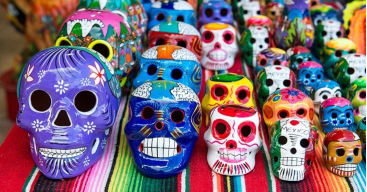
Many of the most important of Oaxaca's best places to visit are to be found in the city's historic downtown core, an area centered around its central square, or Zócalo: the Plaza de Armas. In addition to its attractive bandstand, its beautiful old trees, and countless cafés, it is here that many of the city's most important festivals and events are held, including the extremely colorful Fiesta de Rábanos-quite literally, the Night of the Radishes-which takes place here on December 23rd each year with festivities such as fireworks, dances, and parades spilling over to Christmas (and yes, there's even a radish-carving contest).
Another important focal point is Mercado Benito Juárez, a colorful covered market that is especially lively on Saturdays when local Indios flock here to buy and sell everything from produce and woven articles to earthenware and leather goods. Other colorful markets include the daily Mercado de Abastos and the Mercado de Artesanias with its focus on textile goods.
Source: https://www.planetware.com/tourist-attractions-/oaxaca-mex-oax-oaxc.htm

Travel video of Oaxaca City, Mexico
https://www.youtube.com/watch?v=g-ef3jRsCo8
6. History and Culture
Early settlements
The Zapotec and Mixtec peoples had settlements in valley of Oaxaca for thousands of years, especially in connection with the important ancient centers of Monte Albán and Mitla. Modern Oaxaca city developed relatively near them. The Aztec entered the valley in 1440 and named it "Huaxyacac", a Nahuatl phrase meaning "among the huaje" (Leucaena leucocephala) trees. They created a strategic military position at what is now called the Cerro (large hill) del Fortín to oversee the Zapotec capital of Zaachila and secure the trade route between the Valley of Mexico, Tehuantepec, and what is now Central America.
When the Spanish arrived in 1521, the Zapotec and the Mixtec were involved in one of their many wars. The Spanish conquest ended this fighting, imposing a kind of imperial peace on the area. At the same time, Spanish Catholic missionaries began evangelizing the indigenous peoples, urging them to conversion.
The Spanish arrived on an uncertain date, around 1528. Hernán Pérez de Bocanegra y Córdoba allied himself with the Otomí Indian Conín, chief of Jilotepec, to peacefully conquer the new territories.
In 1531 the layout of the city of Querétaro was made by Juan Sánchez de Alaniz and by Conín, now baptized with a Castilian name: Don Fernando de Tapia.
Spanish colonization
The first Spanish expedition to Oaxaca arrived late in 1521, headed by Captain Francisco de Orozco, and accompanied by 400 Aztec warriors. Hernán Cortés sent Francisco de Orozco to Oaxaca because Moctezuma II had said that the Aztecs' gold came from there. The Spanish expedition under Orozco set about building a Spanish city where the Aztec military post was at the base of the Cerro de Fortín.
The first mass in Oaxaca was given by Chaplain Juan Díaz on the bank of the Atoyac River under a large huaje tree, where the Church of San Juan de Dios would be constructed later. This same chaplain added saints’ names to the surrounding villages, in addition to keeping their Nahuatl names: Santa María Oaxaca, San Martín Mexicapan, San Juan Chapultepec, Santo Tomas Xochimilco, San Matías Jalatlaco, Santiago Tepeaca, etc. This group of Spaniards chose their first mayor, Gutierres de Badajoc, and their first town council, and began construction of the cathedral of Oaxaca in 1522. Their name for the settlement was Guajaca, a Hispanization of the Nahuatl name used by the Aztec (it was later spelled as Oaxaca).
The relatively independent village did not suit Hernán Cortes, who wanted to control power over the entire region. Cortés sent Pedro de Alvarado, who proceeded to drive out most of the village's population. The original Spanish settlers appealed to the Spanish crown to recognize the village they founded, which it did in 1526, dividing the land among the Spaniards of Orozco's expedition. But three months later, Cortés forced out the population of the village once again and replaced the town council with his own appointees. The original founders appealed again to Spanish royal authority, this time to the viceroy in Mexico City, Nuño de Guzmán. He also sided with the original founders; they reestablished the town in 1529, naming it Antequera, in honor of Nuño de Guzmán's hometown. Francisco de Herrera convened the new, Crown-approved town council. Juan Peláez de Berrio platted the new settlement.
In the meantime, Cortés gained from the crown the title of the Marquis of the Valley of Oaxaca, which contains the disputed village. This enabled him to demand high taxes in the area, and to control the territory that surrounded the village. The village had to survive while surrounded by other villages that answered to Cortés. These villages not only did not take orders from Antequera, they were hostile to it, mostly likely encouraged by Cortés.[4]
To counter this, the village petitioned the Crown to be elevated to the status of a city, which would give it certain rights, privileges and exceptions. It would also ensure that the settlement would remain under the direct control of the king, rather than of Cortés. This petition was granted in 1532 by Charles V of Spain.
Early Mexico
After the Independence of Mexico in 1821, the city became the seat of a municipality. The name of both the city and the municipality became Oaxaca, changed from Antequera. In 1872, "de Juárez" was added to the city and municipality names to honor the late Benito Juárez, a native son who had begun his legal and political career here; he had served as president of Mexico from 1858 to his death in 1872.
Modern history
The 2006 Oaxaca protests developed from state actions in 2005. Oaxaca's new state governor Ulises Ruiz Ortíz ordered the assassination of 36 leaders and activists,[citation needed] and banned political demonstrations in the capital's main square and historic center, or Zócalo. He acted to make the Zócalo a modernized tourist attraction, turning the state legislature building into a museum. In summer 2005, Oaxaca's urban middle classes joined in protests against these decisions.
In May 2006, the national teachers union staged their annual occupation of the Zócalo, a union negotiation tactic and local tradition performed every summer since 1989. After a year of protests and growing resistance to the new governor, in 2006 the summer occupation of the square attracted more teachers than usual.
The government announced increases in wages and employment benefits for teachers a short time later. An internal conflict in the local teachers' union led to accusations that the bargaining had not really been in the teachers' best interest. On the night of June 14, the state police attacked and tear-gassed the teachers still sleeping in the Zócalo, generating more public outrage against Governor Ruiz and the ruling Institutional Revolutionary Party.
Many radical groups merged with the teachers' union to form the Popular Assembly of the People of Oaxaca (APPO). This assembly defended the rights of several neighborhoods and organizations against government repression, in particular the "caravanas de la muerte" – death squads of government agents patrolling the city in police trucks. The assembly also closed government buildings, barricaded access roads to the city, and replaced the city's police force with the Honorable Cuerpo de Topiles, a civilian law force based on indigenous traditions of communal policing.
In October 2006 president Vicente Fox sent in more than 10,000 paramilitaries to take back control of the city. Armed confrontations resulted in many deaths, including that of Indymedia journalists Bradley Roland Will, Roberto López Hernández, and Jorge Alberto Beltrán. In late December, teacher's union leaders announced an end to their strike. Several leaders of the APPO were arrested. These grassroots groups continued to clash with local and state government, but finally all the barricades were removed and they turned over control of the city.
7. Other information
Gastronomy
The city of Oaxaca has long been considered "Mexico's culinary capital." The most notable aspect of Oaxacan cuisine is its variety of moles, which are a type of complex sauce. Their origins go back to the melding of Spanish and Arabic food in Spain. After the Conquest, New World ingredients such as chile mulato, 'miltomate' (a small whitish wild tomato), tomatoes, peanuts, avocado leaves, and chocolate were incorporated. While moles can be found in many parts of Mexico, Oaxaca has the greatest variety including negro (black), Colorado (red), coloradito (faint red), chichilo, verde (green), amarillo (yellow), and manchamanteles (lit. 'stainer of tablecloths'). They are sold in markets all over the city as a paste which is combined with water and simmered with a variety of meats.
Other notable foods sold in markets include bars of chocolate (primarily used for making hot chocolate), traditional breads, and chapulines (fried grasshoppers with chile). Street foods include tlayudas, which are large, slightly crispy corn tortillas piled high with ingredients such as grilled beef (called tasajo), cheese, tomatoes, avocados, onions etc. Local drinks include those made with water, sugar and a flavoring such as aguamiel (honey water), trocitos de melón (melon), horchata (rice), tuna batida (cactus fruit shake), and nuez (nuts) as well as local fruits such as chilacayota and guanábana. In nearby Tlacolula and Ejutla an indigenous drink called 'tejate' is still prepared and sold in the local market. Known here as the drink of the gods, it is prepared with corn, cacao, cacao flower and the seed of the mamey fruit. As for alcoholic beverages, this area prefers mezcal, which like tequila is made from agave, but unlike tequila can be made from a variety of different species of the plant.
As in other areas in Mexico, chocolate has had special importance here since long before the Conquest. Aside from being a foodstuff, it was also used as medicine and cacao seeds were used as money. The chocolate prepared in this city is well known within Mexico, as it is distinguished by being flavored with cinnamon, almonds and sugar and is usually prepared with hot water or milk. It is usually served in large coffee cups with a local sweet roll. The best-known producer of this type of chocolate is Chocolate El Mayordomo, which recently has opened outlets in various parts of Mexico, esp. in Mexico City. In their main store in Oaxaca City, you can see them prepare the various types of chocolates they prepare including a chocolate pasta.
The Guelaguetza, also known as the Fiestas de los Lunes del Cerro (Festivals of Mondays at the Hill) is the major cultural event in the city with origins in pre-Hispanic times. The "Hill" is the Cerro del Fortín, which was the scene of the annual rites to the goddess Centeótl, or goddess of the corn. The hill had a teocalli, or sacred plaza, built by the Aztecs. The ritual would end with the sacrifice of a young maiden chosen to represent the goddess.
This rite was prohibited by the Spanish after the Conquest, who also destroyed the teocalli. In its place, they constructed the Church of Our Lady of Mount Carmen, now known as Carmen Alto. The recently baptized Mixtecs and Zapotecs then replaced ceremonies to Centeótl with those to this manifestation of the Virgin Mary, at the same place, the Cerro del Fortín.
This revised festival grew over time to be the largest and most anticipated for the town. In 1932, the city of Oaxaca realized its 400th anniversary and decided to combine these festivities with those of the Cerro del Fortín, adding traditional dances, music, regional cuisine and Margarita Santaella as the first Miss Oaxaca, in addition to the religious rites. The word "guelaguetza" is from Zapotec and means offering, sympathy, caring and cooperation. This first Guelaguetza was such a hit that organizers decided to repeat it every year at the Cerro del Fortin, on all the Mondays of July starting in 1953, becoming an amalgam of Oaxacan festivals from many parts of the state.
8. Contact Information
City Mayor: Oswaldo García Jarquín
Contact number: +52 (951) 501 5500 Ext. 509, 510, 511 y 65
Govt. Office Address: Plaza de la Danza S/N, Col. Centro, C.P. 68000, Oaxaca City, Oax.
Facebook: https://www.facebook.com/oswaldogarciaj/
Twitter: https://twitter.com/oswaldogarciaj?lang=en
